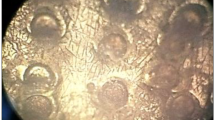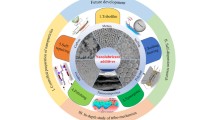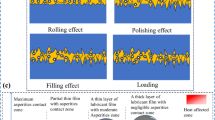Abstract
TiO2/CuO nano-particles were dispersed into lithium grease to improve the lubricating properties of the greases. Then, the process of sliding friction was tested. The friction force of the contact interface between a ball and a flat surface with TiO2/CuO nano-grease was measured for a ball on a flat sliding wear tester. The worn surface was examined by a surface roughness tester and scanning electron microscopy (SEM). The tested lithium grease was synthesized with 0.5wt.%, 1.0wt.%, 1.5wt.% and 2.0wt.% TiO2/CuO nano-particles. Results indicate that the TiO2/CuO nano-particle additives can improve the wear resistance of lithium grease and decrease the friction coefficient. In addition, the results show that a 1.0 wt% content of TiO2 nano-particles is the most efficient in reducing friction and wear, and can significantly reduce the friction coefficient of the rubbing interface by about 40%, according to the friction tests. The wear of the lithium grease with a 2.0wt.% content of CuO nano-particles added can reduce wear about by 60% in comparison with lithium grease. Furthermore, the SEM analysis results demonstrate that the addition of tribo-film forms and TiO2/CuO nano-particles on the worn surface is responsible for the decrease in friction and wear.
Similar content being viewed by others
References
Picas, J. A., Forn, A., Igartua, A., and Mendoza, G., “Mechanical and Tribological Properties of High Velocity Oxy-Fuel Thermal Sprayed Nanocrystalline CrC NiCr Coatings,” Surface and Coatings Technology, Vol. 174, pp. 1095–1100, 2003.
Tarassov, S. Y. and Kolubaev, A., “Effect of Friction on Subsurface Layer Microstructure in Austenitic and Martensitic Steels,” Wear, Vol. 231, No. 2, pp. 228–234, 1999.
Yu, H. L., Xu, Y., Shi, P. J., Xu, B. S., Wang, X. L., and Liu, Q., “Tribological Properties and Lubricating Mechanisms of Cu Nanoparticles In Lubricant,” Transactions of Nonferrous Metals Society of China, Vol. 18, No. 3, pp. 636–641, 2008.
Dommarco, R. C., Bastias, P. C., Rubin, C. A., and Hahn, G. T., “The Influence of Material Build up Around Artificial Defects on Rolling Contact Fatigue Life and Failure Mechanism,” Wear, Vol. 260, No. 11, pp. 1317–1323, 2006.
Tarasov, S., Kolubaev, A., Belyaev, S., Lerner, M., and Tepper, F., “Study of Friction Reduction by Nanocopper Additives to Motor Oil,” Wear, Vol. 252, No. 1, pp. 63–69, 2002.
Su, T., Zhao, J., Xu, D., and Xue, Q., “Study on the Tribological Properties of Ultradispersed Diamond Containing Soot as an Oil Additive,” Tribology Transactions, Vol. 40, No. 1, pp. 178–182, 1997.
Dong, J. X. and Hu, Z. S., “A Study of the Anti-Wear and Friction-Reducing Properties of the Lubricant Additive, Nanometer Zinc Borate,” Tribology International, Vol. 31, No. 5, pp. 219–223, 1998.
Liu, W. and Chen, S., “An Investigation of the Tribological Behaviour of Surface-Modified ZnS Nanoparticles in Liquid Paraffin,” Wear, Vol. 238, No. 2, pp. 120–124, 2000.
Chen, S., Liu, W., and Yu, L., “Preparation of DDP-Coated PbS Nanoparticles and Investigation of the Antiwear Ability of the Prepared Nanoparticles as Additive in Liquid Paraffin,” Wear, Vol. 218, No. 2, pp. 153–158, 1998.
Bartz, W. J., “Some Investigations on the Influence of Particle Size on the Lubricating Effectiveness of Molybdenum Disulfide,” Tribology Transactions, Vol. 15, No. 3, pp. 207–215, 1972.
Wang, F., Bi, Q. L., Wang, X. B., and Liu, W. M., “Sliding Friction and Wear Performance of Ti6Al4V in the Presence of Surface-Capped Copper Nanoclusters Lubricant,” Tribology International, Vol. 41, No. 3, pp. 158–165, 2008.
Zeng, X., Li, J., Wu, X., Ren, T., and Liu, W., “The Tribological Behaviors of Hydroxyl-Containing Dithiocarbamate-Triazine Derivatives as Additives in Rapeseed Oil,” Tribology International, Vol. 40, No. 3, pp. 560–566, 2007.
Chang, H., Chen, X. Q., Jwo, C. S., and Chen, S. L., “Electrostatic and Sterical Stabilization of CuO Nanofluid Prepared by Vacuum Arc Spray Nanofluid Synthesis System (ASNSS),” Materials Transactions, Vol. 50, No. 8, pp. 2098–2103, 2009.
Chang, H. and Lin, S., “Fabrication Method for a TiO2 Nanofluid with High Roundness and Superior Dispersion Properties,” Materials Transactions, Vol. 48, No. 4, pp. 836–841, 2007.
Author information
Authors and Affiliations
Corresponding author
Rights and permissions
About this article
Cite this article
Chang, H., Lan, CW., Chen, CH. et al. Anti-wear and friction properties of nanoparticles as additives in the lithium grease. Int. J. Precis. Eng. Manuf. 15, 2059–2063 (2014). https://doi.org/10.1007/s12541-014-0563-y
Received:
Revised:
Accepted:
Published:
Issue Date:
DOI: https://doi.org/10.1007/s12541-014-0563-y




